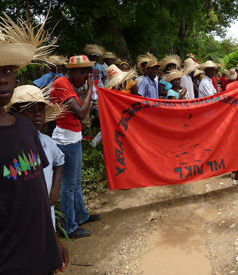
© MediahackerRural Haitian farmers gathered in Papaye, June 4, 2010. Many wore straw hats reading, "Aba Monsanto - down with Monsanto and Aba Preval - down with Preval."
"A fabulous Easter gift," commented Monsanto Director of Development Initiatives Elizabeth Vancil. Nearly 60,000 seed sacks of hybrid corn seeds and other vegetable seeds were donated to post-earthquake Haiti by Monsanto. In observance of World Environment Day, June 4, 2010, roughly 10,000 rural Haitian farmers gathered in Papaye to march seven kilometers to Hinche in celebration of this gift. Upon arrival, these rewarded farmers took their collective Easter baskets of more than 400 tons of vegetable seeds and burned them all.
[i] "Long live the native maize seed!" they chanted in unison. "Monsanto's GMO [genetically modified organism] & hybrid seed violate peasant agriculture!"
According to Chavannes Jean-Baptiste, coordinator of the Papay Peasant Movement (MPP), "there is presently a shortage of seed in Haiti because many rural families used their maize seed to feed refugees."
[ii] Like any benevolent disaster capitalist corporation, Monsanto extended a hand in a time of crisis to the 65 percent of the population that survives off of subsistence agriculture. But not just any hand was extended in this time of great need, rather: a fistful of seeds. The extended fist was full of corn seeds, one of Haiti's staple crops, treated with the fungicide Maxim XO. With similar benevolence, not just any tomato seeds were donated to the agrarian peasants, but tomato seeds treated with Thiram, a chemical so toxic the Environmental Protection Agency (EPA) has ruled it too toxic to sell for home garden use, further mandating that any agricultural worker planting these seeds must wear special protective clothing.
[iii] Happy Easter! Monsanto's web site's official explanation for this toxic donation is that "fungicidal seed treatments are often applied to seeds prior to planting to protect them from fungal diseases that arise in the soil and hamper the plant's ability to germinate and grow. The treatments also provide protection against diseases the seed might pick up in transfer between countries."
[iv] However, according to the New Jersey Department of Health and Senior Services Hazardous Substance Fact Sheet, "repeated exposure [to Thiram] can affect the kidneys, liver and thyroid gland. High or repeated exposure may damage the nerves."
[v] Why would Monsanto be so eager to donate seeds that could potentially compromise the health of so many famished people?
